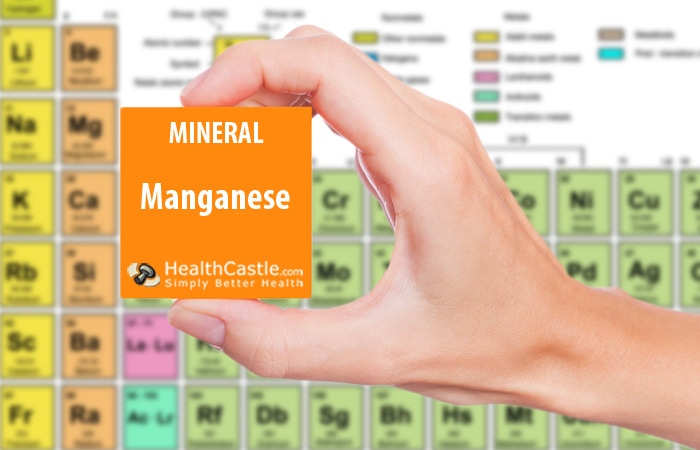
Written By: Carolyn Berry, RD
Title: Registered Dietitian
Alumni: University of British Columbia
Last Updated on:


Manganese is a trace mineral present in tiny amounts in the body. It is found mostly in bones, the liver, the kidneys, and the pancreas.
Table of Contents
The Dietary Reference Intakes (DRI) for manganese are shown below:
| Age Group | Recommended Dietary Allowance (RDA) per Day | Tolerable Upper Intake Level (UL) per Day |
| Adults | ||
| 19 years and up | 2.3 mg male1.8 mg female | 11 mg |
| Kids and Youth | ||
| 1 to 3 years | 1.2 mg | 2 mg |
| 4 to 8 years | 1.5 mg | 3 mg |
| 9 to 13 years | 1.9 mg male1.6 mg female | 6 mg |
| 14 to 18 years | 2.2 mg male1.6 mg female | 9 mg |
| Special Considerations | ||
| Pregnant women 14 to 18 years | 2.0 mg | 9 mg |
| Pregnant women 19 years and up | 2.0 mg | 11 mg |
| Lactating women 14 to 18 years | 2.6 mg | 9 mg |
| Lactating women 19 years and up | 2.6 mg | 11 mg |
Manganese plays an important role as a coenzyme. It activates the enzymes that are important in bone formation. It also assists in the synthesis of fatty acids and cholesterol, and facilitates protein and carbohydrate metabolism. Manganese also activates the enzymes responsible for utilization of several key nutrients, including thiamin, biotin, ascorbic acid, and choline. It works as part of an antioxidant enzyme by protecting our bodies against free radicals and is involved in the formation of urea, the primary component of urine. Manganese also assists in the metabolism of blood sugar.
Both manganese deficiency and manganese toxicity are rare. Deficiency can lead to impaired growth and reproductive function, reduced bone density and impaired skeletal growth, impaired glucose and lipid metabolism, and skin rash. Toxicity results in impairment of the neuromuscular system, including muscle spasms and tremors.
Manganese is widely distributed in foods. Grain products, bran, beans, nuts, vegetables, certain fruits, and brewed tea contain generous amounts. Meats and dairy products contain very small amounts. Significant amounts of manganese can be lost in food processing, especially in the milling of whole grains to produce flour, and in the cooking of beans.
| Food | Manganese per serving |
| Garbanzo beans, cooked, 3/4 cup | 1.2 mg |
| Spelt, cooked, 1/2 cup | 1.1 mg |
| Brown rice, cooked, 1/2 cup | 1.1 mg |
| Pineapple, 1/2 cup diced | 0.8 mg |
| Peanuts, raw, 1/4 cup | 0.7 mg |
| Cashews, raw, 1/4 cup | 0.5 mg |
| Kale, raw, 1 cup chopped | 0.5 mg |
| Brewed tea, 1 cup | 0.5 mg |
| Raspberries, 1/2 cup | 0.4 mg |
| Grapes, 1/2 cup | 0.3 mg |
| Spinach, raw, 1 cup | 0.3 mg |
In the United States: The % daily value gives you an idea of how much manganese is in the food you eat. The daily value for manganese is 2 mg, which is slightly higher than the DRI for adults. The number you see on the Nutrition Facts label is a percentage calculated by dividing the amount of manganese in one serving of the food by the DV. Using an example from the above table, 1/2 cup of diced pineapple containing 0.8 mg of manganese would have 40% of the DV for manganese. The FDA does not require that the % daily value for manganese be listed on the Nutrition Facts label.
In Canada: The daily value for manganese in Canada is also 2 mg. Listing the daily value for manganese on the Nutrition Facts label is optional.
Iron, copper, and zinc: High doses of manganese may inhibit the absorption of iron, copper, and zinc. Conversely, high intakes of iron, copper, and zinc may inhibit the absorption of manganese.
Magnesium, calcium, and phosphorus: High intakes of magnesium, calcium, and phosphorus may inhibit the absorption of manganese.
Alumni: University of British Columbia – Carolyn Berry is a Vancouver-based Registered Dietitian, self-proclaimed foodie, marathon runner, and owner of Berry Nourished. Carolyn works in a variety of areas including clinical nutrition, outpatient counselling at Medisys Preventive Health Clinic, as a nutrition tour leader with Save-On-Foods, and in the media, including segments on CBC Television, CKNW and Spice Radio. Through informative and practical nutrition advice and her food-first approach to health, Carolyn fulfills her passion to empower others with knowledge about nutrition so that they can make the best decisions to improve their health. She strongly believes that food should be both healthful and delicious.
manganese, micronutrient - minerals, minerals, vitamins - minerals
Nutrition 101: Vitamin E | Names | Food List
Trans Fats On the Way Out? The FDA Moves to Ban Partially Hydrogenated Oils